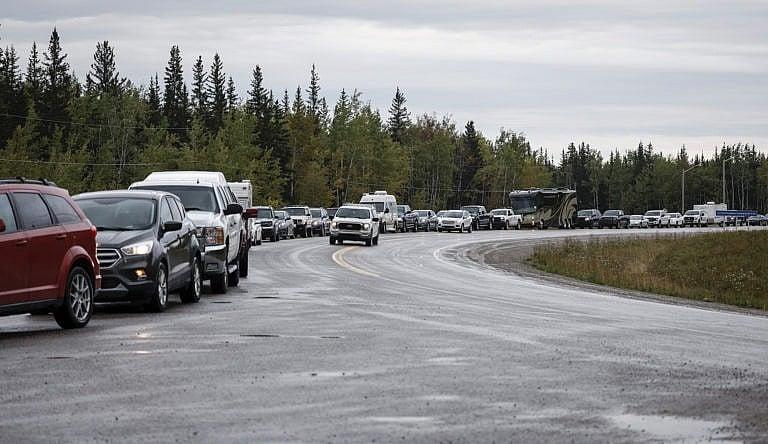“Sixty-three per cent of N.W.T’s population have been evacuated”
Alty says at least 6,500 residents have left since the evacuation order was given on Wednesday, with more departing today

Vehicles line-up for fuel at Fort Providence, N.W.T., on the only road south from Yellowknife, Thursday, Aug. 17, 2023. THE CANADIAN PRESS/Jeff McIntosh
Share

Rebecca Alty has already lived through one wildfire scare. Before she was mayor of Yellowknife, she was living in the city when more than 300 forest fires burned in the Northwest Territories in 2014. The smoke heavily impacted the city, but no one was forced to leave. Now, over the last week, Alty has overseen a Yellowknife first: a complete evacuation of the city in 36 hours, as wildfires raged just kilometres from homes and businesses. We spoke with Alty about the ongoing efforts to fight the fires and get people out of the city.
How are you holding up?
Today’s a tough day. The adrenaline’s slowly wearing off, and I’m starting to get tired. The good news is we’ve got a bunch of fresh fire fighting crews coming in today.
Yellowknife was last significantly threatened by forest fires in 2014. How has emergency planning and evacuation planning evolved in the city since then?
In 2019, we created a wildfire master plan that identified areas in the community where we would have vulnerabilities when it comes to wildfires. That work has really helped to identify all the fire breaks needed right now. It’s all three levels of government, plus private contractors, working together on fighting the fire and evacuation.
READ: “It’s like going off to war”: This man is helping evacuate fire-plagued Yellowknife
People have been leaving the city since last weekend. Do you think that the evacuation order could have come sooner?
Looking at the fire’s behaviour, then also calculating how long it would take to evacuate the city, by Wednesday it was decided that a full community evacuation was going to be needed. I know residents were preemptively leaving before that. The same thing happened in 2014—not only due to the stress of the fire, but because of the smoke. If you’ve got a medical condition, you might look to go down south because of the air quality.

How many people have actually left the city?
We don’t have firm numbers yet. But we do encourage everybody to fill out the evacuation registration portal. We do know that over 5,118 vehicles have crossed the Deh Cho Bridge on Thursday and Friday, which leads to the only road out of Yellowknife. How many people are in the cars? It’s tough to say. The evacuation flights had 1,500 people yesterday. There are also commercial flights that left yesterday, and again today. The highway is also still open, so we’re encouraging anybody who can to still drive out to use the highway.
I know you’re responsible for the whole city, but you must also be thinking about your own family members and friends.
I just had a moment to breathe and I was scrolling Facebook and seeing the number of friends who have made it safely south. It’s great. My family has also managed to evacuate. We have relatives down south that are helping. It’s good to have friends and family support one another through this, as I’m also navigating evacuating the whole city. But it’s a big stress, that’s for sure.
RELATED: Canada in the Year 2060
Hopefully it doesn’t come to this, of course, but is there a point where you imagine you’re going to have to leave the city as well?
We’ll keep monitoring the situation. If the full city was ever threatened and all residents should leave, by all means, myself and all the essential workers here would go. At this stage we’re not there. So we’ll continue, like we have all week, to monitor the situation and determine what steps are necessary.

I know that in the last few days there were some positive developments: the fire didn’t move as much as it was predicted to, there was some light rain, there are more fire fighting crews coming. So how are you feeling right now about what the day might bring?
Yes, it was really helpful. The fire only moved one kilometre instead of the forecasted five. That bought us more time to be able to make fire breaks—areas in which fire-prevention tools like sprinklers are placed to prevent the fire from moving. The crews have been working hard: 150 hectares of trees have been removed between the fire and the city. Sprinklers have been set up. They’re dousing the west side of our community. But today is a challenge. It’s a windy day, so the fire could move a lot.
Climate change has had a huge impact on the increase in wildfires. Do northern communities need more support to combat it in the future?
For sure. When you look at a lot of the fires, they’re affecting tiny communities. Many are Indigenous communities. The amount of work it takes to prepare a community to be ready or to reduce the risk of a fire—that’s more money than the community generally has.

We need to have a conversation as a nation on how we prepare for and fight fires. Nine communities in the Northwest Territories are being evacuated. I think that’s 63 per cent of our population. It’s like nothing we’ve seen. We’ve never had to evacuate the community of Yellowknife. This is the closest the wildfires have ever come to our capital city. But a big thanks to all the municipalities in Alberta who are opening their doors. I know how much work it is. I also know how generous Canadians are with stepping up. It’s a really difficult time. So we really appreciate any support that residents and businesses can provide to evacuees.
This interview has been edited for length and clarity.